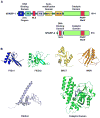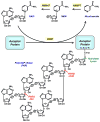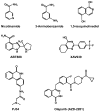The PARP side of the nucleus: molecular actions, physiological outcomes, and clinical targets
- PMID: 20603072
- PMCID: PMC2923840
- DOI: 10.1016/j.molcel.2010.06.017
The PARP side of the nucleus: molecular actions, physiological outcomes, and clinical targets
Abstract
The abundant nuclear enzyme PARP-1, a multifunctional regulator of chromatin structure, transcription, and genomic integrity, plays key roles in a wide variety of processes in the nucleus. Recent studies have begun to connect the molecular functions of PARP-1 to specific physiological and pathological outcomes, many of which can be altered by an expanding array of chemical inhibitors of PARP enzymatic activity.
2010 Elsevier Inc. All rights reserved.
Figures








References
-
- Aguilar-Quesada R, Munoz-Gamez JA, Martin-Oliva D, Peralta A, Valenzuela MT, Matinez-Romero R, Quiles-Perez R, Menissier-de Murcia J, de Murcia G, Ruiz de Almodovar M, Oliver FJ. Interaction between ATM and PARP-1 in response to DNA damage and sensitization of ATM deficient cells through PARP inhibition. BMC Mol Biol. 2007;8:29. - PMC - PubMed
-
- Ahel I, Ahel D, Matsusaka T, Clark AJ, Pines J, Boulton SJ, West SC. Poly(ADP-ribose)-binding zinc finger motifs in DNA repair/checkpoint proteins. Nature. 2008;451:81–85. - PubMed
-
- Alvarez-Gonzalez R, Jacobson MK. Characterization of polymers of adenosine diphosphate ribose generated in vitro and in vivo. Biochemistry. 1987;26:3218–3224. - PubMed
Publication types
MeSH terms
Substances
Grants and funding
LinkOut - more resources
Full Text Sources
Other Literature Sources
Miscellaneous

